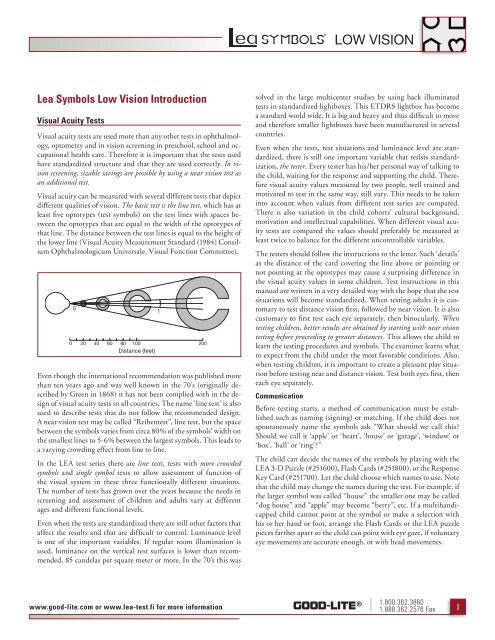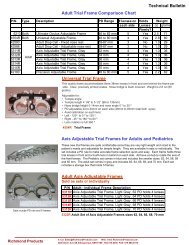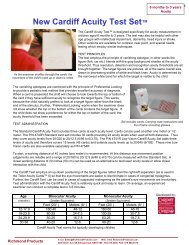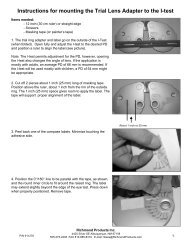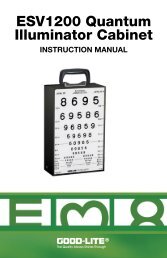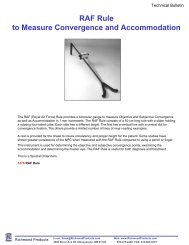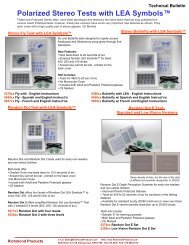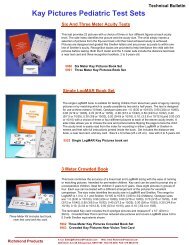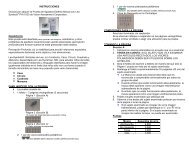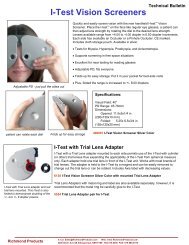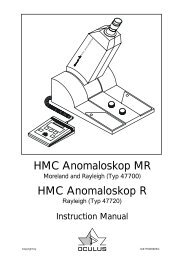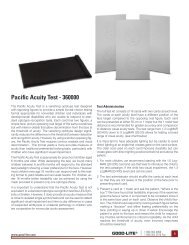download Lea Symbols PDF - Richmond Products
download Lea Symbols PDF - Richmond Products
download Lea Symbols PDF - Richmond Products
You also want an ePaper? Increase the reach of your titles
YUMPU automatically turns print PDFs into web optimized ePapers that Google loves.
LOW VISION<br />
<strong>Lea</strong> <strong>Symbols</strong> Low Vision Introduction<br />
Visual Acuity Tests<br />
Visual acuity tests are used more than any other tests in ophthalmology,<br />
optometry and in vision screening in preschool, school and occupational<br />
health care. Therefore it is important that the tests used<br />
have standardized structure and that they are used correctly. In vision<br />
screening, sizable savings are possible by using a near vision test as<br />
an additional test.<br />
Visual acuity can be measured with several different tests that depict<br />
different qualities of vision. The basic test is the line test, which has at<br />
least five optotypes (test symbols) on the test lines with spaces between<br />
the optotypes that are equal to the width of the optotypes of<br />
that line. The distance between the test lines is equal to the height of<br />
the lower line (Visual Acuity Measurement Standard (1984) Consilium<br />
Ophthalmologicum Universale, Visual Function Committee).<br />
5 l 1 l<br />
0 20 40 60 80 100 200<br />
Distance (feet)<br />
Even though the international recommendation was published more<br />
than ten years ago and was well known in the 70’s (originally described<br />
by Green in 1868) it has not been complied with in the design<br />
of visual acuity tests in all countries. The name ‘line test’ is also<br />
used to describe tests that do not follow the recommended design.<br />
A near vision test may be called “Reihentest”, line test, but the space<br />
between the symbols varies from circa 80% of the symbols’ width on<br />
the smallest lines to 5-6% between the largest symbols. This leads to<br />
a varying crowding effect from line to line.<br />
In the LEA test series there are line tests, tests with more crowded<br />
symbols and single symbol tests to allow assessment of function of<br />
the visual system in these three functionally different situations.<br />
The number of tests has grown over the years because the needs in<br />
screening and assessment of children and adults vary at different<br />
ages and different functional levels.<br />
Even when the tests are standardized there are still other factors that<br />
affect the results and that are difficult to control. Luminance level<br />
is one of the important variables. If regular room illumination is<br />
used, luminance on the vertical test surfaces is lower than recommended,<br />
85 candelas per square meter or more. In the 70’s this was<br />
solved in the large multicenter studies by using back illuminated<br />
tests in standardized lightboxes. This ETDRS lightbox has become<br />
a standard world wide. It is big and heavy and thus difficult to move<br />
and therefore smaller lightboxes have been manufactured in several<br />
countries.<br />
Even when the tests, test situations and luminance level are standardized,<br />
there is still one important variable that resists standardization,<br />
the tester. Every tester has his/her personal way of talking to<br />
the child, waiting for the response and supporting the child. Therefore<br />
visual acuity values measured by two people, well trained and<br />
motivated to test in the same way, still vary. This needs to be taken<br />
into account when values from different test series are compared.<br />
There is also variation in the child cohorts’ cultural background,<br />
motivation and intellectual capabilities. When different visual acuity<br />
tests are compared the values should preferably be measured at<br />
least twice to balance for the different uncontrollable variables.<br />
The testers should follow the instructions to the letter. Such ‘details’<br />
as the distance of the card covering the line above or pointing or<br />
not pointing at the optotypes may cause a surprising difference in<br />
the visual acuity values in some children. Test instructions in this<br />
manual are written in a very detailed way with the hope that the test<br />
situations will become standardized. When testing adults it is customary<br />
to test distance vision first, followed by near vision. It is also<br />
customary to first test each eye separately, then binocularly. When<br />
testing children, better results are obtained by starting with near vision<br />
testing before proceeding to greater distances. This allows the child to<br />
learn the testing procedures and symbols. The examiner learns what<br />
to expect from the child under the most favorable conditions. Also,<br />
when testing children, it is important to create a pleasant play situation<br />
before testing near and distance vision. Test both eyes first, then<br />
each eye separately.<br />
Communication<br />
Before testing starts, a method of communication must be established<br />
such as naming (signing) or matching. If the child does not<br />
spontaneously name the symbols ask “What should we call this?<br />
Should we call it ‘apple’ or ‘heart’, ‘house’ or ‘garage’, ‘window’ or<br />
‘box’, ‘ball’ or ‘ring’?”<br />
The child can decide the names of the symbols by playing with the<br />
LEA 3-D Puzzle (#251600), Flash Cards (#251800), or the Response<br />
Key Card (#251700). Let the child choose which names to use. Note<br />
that the child may change the names during the test. For example, if<br />
the larger symbol was called “house” the smaller one may be called<br />
“dog house” and “apple” may become “berry”, etc. If a multihandicapped<br />
child cannot point at the symbol or make a selection with<br />
his or her hand or foot, arrange the Flash Cards or the LEA puzzle<br />
pieces farther apart so the child can point with eye gaze, if voluntary<br />
eye movements are accurate enough, or with head movements.<br />
www.good-lite.com or www.lea-test.fi for more information<br />
1.800.362.3860<br />
1.888.362.2576 Fax
LOW VISION<br />
Luminance Level<br />
Luminance level should be kept at or above the standard level of 85<br />
candelas per square meter. This is difficult to achieve in a regular<br />
room because the test is vertical and thus does not reflect much of<br />
the light from ceiling lamps. The small lightbox for the 9"x14" tests<br />
has a luminance level of 120 cd/m 2 . During measurement of near<br />
vision luminance level is usually at acceptable levels because the test<br />
is held tilted to be perpendicular to the line of sight of the child.<br />
Definition of Visual Acuity Threshold<br />
According to the Visual Acuity Measurement Standard, “A line of<br />
optotypes is generally considered to have been read correctly when<br />
more than 50% (e.g., 3 of 5, 4 of 6) of the optotypes presented have<br />
been read correctly.”<br />
Details About Testing<br />
Start testing with binocular testing at near. Distance testing and<br />
monocular testing with occlusion of one eye follows naturally once<br />
confidence with the child is established. When testing monocularly,<br />
test the right eye (O.D.) first followed by the left eye (O.S.), unless<br />
there is an obvious negative response to occlusion of the left eye.<br />
In follow up testing and in amblyopia training the -1, -2, and +1,<br />
+2 system should be used to give credit for minimal changes. For<br />
example, “20/32 (+1)” “( 6/9.5 (+1) or 0.63 (+1)” indicates the child<br />
met the 20/32 line criteria and also correctly named one symbol on<br />
the next smaller size, 20/25 ( 6/7.5 or 0.8).<br />
Since these tests are mainly used in amblyopia screening it is important<br />
to keep in mind that skipping symbols is a feature typical<br />
to amblyopic eyes. Even if the visual acuity difference is less than<br />
two lines between the eyes, it is an important finding. If one notices<br />
that the child has motor difficulties, like skipping symbols, the tester<br />
should be alerted to the possibility that the child might have beginning<br />
mild amblyopia developing in an eye or has undiagnosed brain<br />
damage.<br />
Visual acuity charts are among the least expensive clinical tests that<br />
we use. However, in a number of hospitals and screening places visual<br />
acuity tests have not been replaced in 10-15 years. The tests are<br />
old, brown and smudged, no more proper high contrast tests. Take<br />
good care of your tests, do not leave them in sunshine and clean<br />
them with a nonabrasive detergent. Watch that children do not have<br />
an opportunity to draw on your tests with pen. Never use a pen to<br />
point on optotypes when you are testing a child who cannot fixate<br />
at the symbols without pointing. Use a pointed wooden stick. The<br />
low contrast visual acuity charts need special attention, keep them<br />
in the plastic cover.<br />
Instructions<br />
• When examining young children, introduce the distance chart<br />
to the child after near testing by saying, “Let’s look at the same<br />
pictures a little further away.”<br />
• Point to the first symbol in each line in descending order when<br />
testing binocularly.<br />
• Move down until the child hesitates or misidentifies a symbol.<br />
• Move back up one line and ask the child to identify all the<br />
symbols on that line.<br />
• If the child identifies all symbols correctly go to the next line<br />
with smaller symbols and ask the child to identify all symbols on<br />
that line.<br />
• If the child skips a symbol ask the child to try again while briefly<br />
pointing to that symbol.<br />
• A child with fixation problems may skip symbols within a line of<br />
symbols.<br />
• Visual acuity is recorded as the last line on which at least 3 of<br />
the 5 symbols are identified correctly. The visual acuity value is<br />
found in the margin adjacent to that line.<br />
• After obtaining good responses with binocular testing, proceed<br />
by testing each eye separately.<br />
• When testing monocularly, use the first symbol of each line or<br />
every second line for one eye and the last symbol of each line for<br />
the other eye to determine on which line to start testing close to<br />
the threshold value.<br />
• If the child has profound low vision, the lowest rows of the test<br />
can be used as a near vision test. The distance of 25 cm is the<br />
most practical distance because calculation of the visual acuity<br />
values is simple. They are ¼ of the value printed next to the last<br />
line read. (To calculate ¼ of a Snellen value, you multiply the<br />
denominator by 4.)<br />
www.good-lite.com or www.lea-test.fi for more information<br />
1.800.362.3860<br />
1.888.362.2576 Fax


